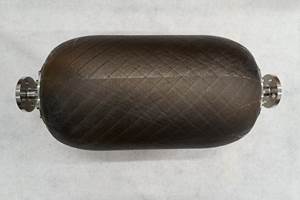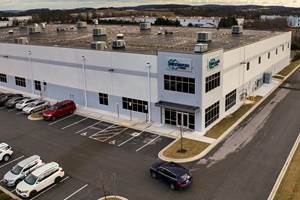Some predictions for 2017
We will see even greater progress in 2017 than we saw in 2016, some surprising, some long awaited.
Last month, I articulated that composites technology is advancing at an unprecedented rate, and this will have significant impacts on future adoption. This year, some notable technologies have made advanced composites more affordable: increased automation, reduced cycle times, and the introduction of a carbon fiber made from textile PAN with the properties of industrial fibers made with specialty PAN, which offers the potential for significant reductions in the cost of raw carbon fibers and the resulting composite structures they reinforce. As 2016 comes to an end, I will hazard some predictions about what I think we will see happen between now and the end of 2017.
I say “hazard” for good reason. As we all know, prediction is risky business. Like the weather, things change, and uncertainty can come into play, especially as events like contentious presidential elections and potential economic crises (Brexit, anyone?) are added to the mix. However, based on what I see happening in the marketplace, I think we will see even greater progress in 2017 than we saw in 201 6, someof which might be surprising and long awaited. Although I might miss the mark, or maybe the timing, on some of these, we have to remember that even great footballers like Lionel Messi and Cristiano Ronaldo have less than a perfect record in penalty kicks.
Let’s start with commercial aerospace. I predict either Airbus or Boeing will announce plans to develop a single-aisle replacement (or maybe upgrade) for the A320neo or 737 MAX, featuring carbon fiber wings. This is an extension of the success of the Boeing 777X, which also replaced aluminum with carbon fiber in the wings, and is driven in part by the commercialization of carbon wing technology in the new single-aisle offerings from Bombardier and Irkut Corp. Although the first flight of such a new offering from the “big boys” would still be a couple years away, it would nonetheless spark a great deal of excitement in the industry.
In the automotive world, there has been a lot of speculation that BMW would extend its Carbon Core philosophy used on the 7 Series to the redesigned 2017 version of the much larger volume 5 Series, which was publicly unveiled late in 2016. As of this writing, it does not appear to incorporate carbon fiber. However, I feel that we will see a high-performance (perhaps M Series) version incorporate some level of carbon fiber in 2017. While BMW is more or less expected to do more in carbon fiber, I predict that at least one other European and one major US carmaker will each unveil in 2017 plans for vehicles with a similar multi-material approach — namely, strategic use of carbon fiber in stiffening elements for the body structure, rather than cosmetic body panels. And one of these platforms will be in excess of 100,000 vehicles per year. On the technology side, we will see a major breakthrough in commercial application of automated fiber/tape placement for automotive structures, demonstrating material scrap rates of less than % for complex structures.
In other industrial markets, the wind industry will see its biggest year in history, as the levelized cost of energy (LCOE) harvested from wind closes on that derived from fossil fuels, in some cases besting coal and, in Europe, even natural gas. A record number of composite infrastructure projects will be authorized, because composites will be seen as a cost-effective approach to replace failing bridges, especially in the US. Also, the economics of recycled carbon fiber will be fully validated, with much of the fiber finding its way into consumer products, such as tablet and laptop cases, produced by the millions. Although much of the fiber will be “repurposed scrap” (e.g., dry fiber cuttings from textiles), at least some will be reclaimed from prepreg or cured parts.
Everyone’s hot topic, large-format polymer 3D printing, a subset of additive manufacturing, will find its real value proposition in 2017 for the production of tooling for composites. On the low-temperature end, 3D printing of preforming, trimming, drilling and check fixtures will represent a great market opportunity for tooling companies that are, today, machining these from metals or tooling board. Rapid advances in printing of carbon fiber-reinforced, high-temperature polymers, such as PPS, will see such tools deployed for serial production of autoclave-cured parts, and for low-cost, rapid-prototype tooling for compression and injection molded components.
It all sounds perfectly rosy, right? Not quite. While most composites markets are doing well in 2017 , I think the going could be difficult for composites in the defense, oil exploration and marine sectors, and lukewarm in sporting goods. Of course, I’ll be delighted if I am wrong about these markets. In this case, I’ll happily be the weather forecaster that predicts that blizzard that never comes.
Related Content
Infinite Composites: Type V tanks for space, hydrogen, automotive and more
After a decade of proving its linerless, weight-saving composite tanks with NASA and more than 30 aerospace companies, this CryoSphere pioneer is scaling for growth in commercial space and sustainable transportation on Earth.
Read MoreNCC reaches milestone in composite cryogenic hydrogen program
The National Composites Centre is testing composite cryogenic storage tank demonstrators with increasing complexity, to support U.K. transition to the hydrogen economy.
Read MoreHexagon Purus opens new U.S. facility to manufacture composite hydrogen tanks
CW attends the opening of Westminster, Maryland, site and shares the company’s history, vision and leading role in H2 storage systems.
Read MoreRecycling end-of-life composite parts: New methods, markets
From infrastructure solutions to consumer products, Polish recycler Anmet and Netherlands-based researchers are developing new methods for repurposing wind turbine blades and other composite parts.
Read MoreRead Next
Plant tour: Daher Shap’in TechCenter and composites production plant, Saint-Aignan-de-Grandlieu, France
Co-located R&D and production advance OOA thermosets, thermoplastics, welding, recycling and digital technologies for faster processing and certification of lighter, more sustainable composites.
Read More“Structured air” TPS safeguards composite structures
Powered by an 85% air/15% pure polyimide aerogel, Blueshift’s novel material system protects structures during transient thermal events from -200°C to beyond 2400°C for rockets, battery boxes and more.
Read MoreAll-recycled, needle-punched nonwoven CFRP slashes carbon footprint of Formula 2 seat
Dallara and Tenowo collaborate to produce a race-ready Formula 2 seat using recycled carbon fiber, reducing CO2 emissions by 97.5% compared to virgin materials.
Read More


















